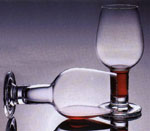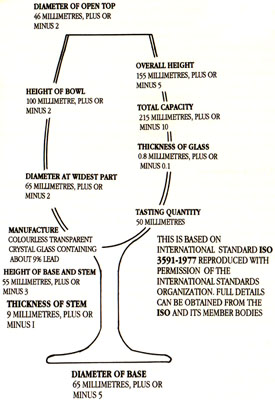|
|
|
|
|
Get
all the evaluations for
the December
Release The
stem game National Post Weekly Wine & Spirits Columnist Saturday, December 28, 2002 With
Boxing Day sales in swing, now may be the perfect time to consider
upgrading your stemware. The fact is; the glass that maketh the wine.
This is a sermon that has been preached with religious fervour by Georg
Riedel, a 10th generation Austrian glassmaker. His
family’s firm is credited with the creating to revolution in wine
tasting glasses. It happened in 1958 with the introduction of the
Burgundy Grand Cru glass, which was designed for connoisseurs who wanted
to extract the last ounce of flavour from their prized possessions.
Indeed, it is the only stemware to reside permanently in New York
City’s Museum of Modern Art. Quite frankly, I was
somewhat skeptical when I first heard that the shape of the glass could
profoundly change taste. After all, shouldn’t wine be pretty much the
same in any glass? Surely it was like going to a movie, no matter where
you sit in the theatre the picture on the screen remains identical. Were
it only so simple when it comes to wine.
It all sounds quite
complicated and, in fact, it is. The reality, however, is that you
don’t have to be rich or even be drinking an expensive wine to benefit
from using the right glass. Ah yes, the “right” glass. Riedel tried
to make it idiot-proof by creating an ideal glass for each wine. This
noble and presumably profitable effort actually works, at least in most
cases. The reason I say “most” is that each glass will emphasize a
different set of characteristics. As a result how much you like an
individual glass will depend upon how much you like the characteristics
the glass is either emphasizing or suppressing. Ultimately, this means
that what might be perfect for one taster may not be ideal for another-
a dilemma which became evident when I worked on Riedel’s panel trying
to come up with the “perfect” icewine glass. To make the point stick,
for the past two autumns the LCBO has orchestrated the Mondavi-Riedel
“wine-glass show tour”. This sold out seminar has a certain Abbot
and Costello air to it. “Look
how bad this wine tastes,” says Georg Riedel sternly, swirling the
Mondavi’s Sauvignon Blanc in the huge Pinot Noir glass. Meanwhile
Michael Mondavi cringes and goes on to suggest that “it
doesn’t taste bad, it is just does not taste as good.” And that is a real
problem. It is the big secret that many wine writers fail to address.
Even Robert Parker, who acknowledges the extreme importance of the
glass, doesn’t open this can of worms. Why? Well imagine suggesting
that a wine gets 88 points in the one glass, could get 90 points in
another. Which score is right? In my opinion both are correct. Do I hear
choruses of “say it isn’t so?” To overcome this
impasse, most professionals use an identical glass (called the ISO
glass) for all evaluations. This, at least, creates a level playing
field wherein every wine is afforded an equal opportunity to strut its
stuff. It also provides a consistent and comparable platform for
comparing wine tasting notes.
Recent research,
however, indicates that this, smallish, International Standards
Organization vessel doesn’t necessarily work equally well for all
wines. According to John Nadeau owner of Toronto’s Wine Establishment,
Riedel and Mondavi created an innovative general tasting glass (code
#416/22), which holds two sips of wine in the bottom of its stubby
hollow stem. The idea is that it can be rolled on its side permitting
the wine to coat the glass thereby maximizing bouquet. It lists for
$39.95 (or $34.95 at the Wine Establishment). Would I buy one? The
answer is no because I find it too awkward to use. In addition, who has
the space and patience to actually roll the glass on a table to get the
smell when a simple swirl will do the trick?
In fact, almost all the
major manufacturers offer some kind of solution. Unfortunately, there is
no simple answer to the dilemma of trying to ensure that tasting notes
are compatible at least from a glass point of view. If, for instance,
one wishes to replicate my tasting impressions, one has to use the same
ISO tasting glass. In its least expensive mode, Royal Leerdam’s
everyday less preferred “rolled” rim version fetches between
$2.50-$3.00 per stem. By contrast, the 9% lead crystal Bohemian Belfor
with a superior cut rim sells for $17.95 per pack of four (Wine
Establishment).
The key disadvantage of
using an ISO glass, it that it does not necessarily make the wine taste
best. As you will naturally want to maximize all the enjoyment a wine
has to offer, you are obliged to play the stem game to find which is
most appropriate. Unfortunately, I have
found Riedel’s higher end pricier stems all-too-easy to break. As a
result, I and countless others switched to Spiegelau’s light,
versatile Vino Grande series (approximately $15) which is sturdier and
fairly dishwasher safe. Basically, this German manufacturer produces
Riedel Vinum-styled knock-offs at almost half the Riedel price. Of
course, there are many other brands. In addition to the Wine
Establishment, William Ashley carries a wide variety of stems, including
their own all-purpose 14-ounce goblets, which retail for $33.50 for six. With competition
becoming ever fiercer, one might ask, “do I really need a $100 Riedel
Sommelier glass to enjoy my wine?” Of course, the answer is no. In
fact, Riedel covers all the bases by offering seven different series of
glasses at various price points and as many as 19 different shapes in
24% lead crystal. In a recent attempt to reestablish trade sales where
they were loosing market share, Riedel launched the inexpensive
“Riedel Restaurant” line of durable stems, which sell for less than
one-third of their Vinum line. It has exactly the same bowl but without
the lead. Priced as low as $7.35 a stem in volume, this bargain is not
available to the public. For New Year’s Eve, I
suggest you switch from the narrow flutes that suppress the bouquet to a
tulip-shaped design. A fine less expensive choice includes the more
classic Spiegelau Vino Grande #7 at $12.50. An identically priced Riedel
Overture (408/48) has an invisible laser-etched curve on the interior of
the glass which causes the Champagne bubbles to magically swirl towards
the surface. Of course, all of this will not help if the sparkler is ice
cold rendering tasteless or if the glass is over-filled meaning that you
will not be able to swirl and smell. Last but not least is the ritual of cleaning the glasses. In the dishwasher department, let me highly recommend the KitchenAid KUDR01TJ, which is truly outstanding. After having suffered the slings and arrows of more than two decades of various disappointments, I bought one on sale for just over a thousand dollars exactly twelve months ago and have never been happier. Not only is it silent, but I have never suffered from broken or spotty glasses. Now where is that Champagne?
Champagne glasses from a century old French manufacturer’s catalogue the Riedel “roller” tasting glass the classic ISO glass.
Thanks for your support and all the best for the holiday season.
Check out the
| ||
|
Copyright Food & Beverage Testing Institute of Canada
2004 |

 In
fact, every aspect of the glass, from the shape of the bowl, the size of
the opening, even the thickness and finishing of the rim markedly
influences perception. It has been scientifically proven that different
parts of the tongue perceive different aspects of a wine – tannins,
sweetness, bitterness and sourness. Thus, the Bordeaux glass directs the
wine to flow to the tip and center of the tongue first, which senses
sweetness, will reduce the impression of bitterness, which is picked up
at the side and back of the palate.
In
fact, every aspect of the glass, from the shape of the bowl, the size of
the opening, even the thickness and finishing of the rim markedly
influences perception. It has been scientifically proven that different
parts of the tongue perceive different aspects of a wine – tannins,
sweetness, bitterness and sourness. Thus, the Bordeaux glass directs the
wine to flow to the tip and center of the tongue first, which senses
sweetness, will reduce the impression of bitterness, which is picked up
at the side and back of the palate.

